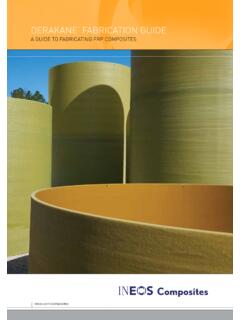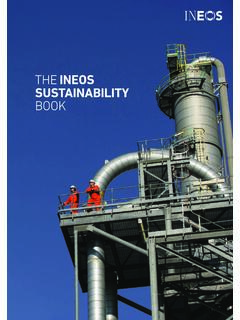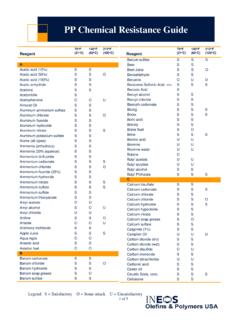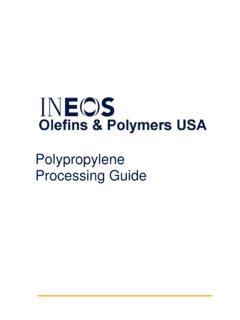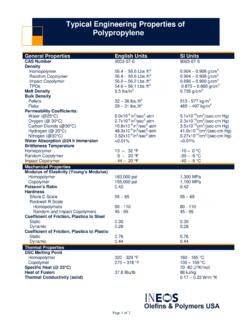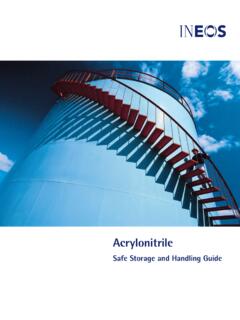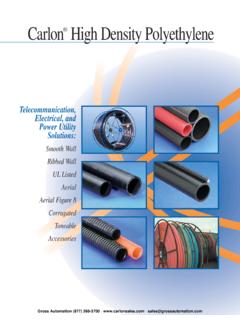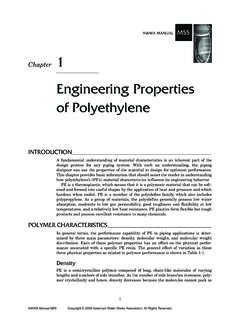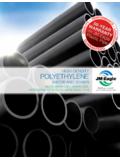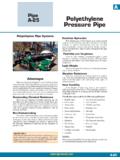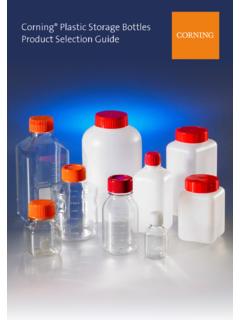Transcription of Environmental Stress Crack Resistance of Polyethylene
1 Environmental Stress Crack Resistance of Polyethylene Introduction to Environmental Stress Cracking and ESCR Over the past decade, high - density Polyethylene (HDPE) materials have improved significantly and now meet more stringent performance standards. Some performance evaluation tests that once took only days to run now take months with today s resins. One such performance criteria is Environmental Stress Crack Resistance (ESCR). Because standard test methods for measuring ESCR on plastics take such a long time (sometimes months) the quality of the material is judged acceptable if the failure time exceeds a certain limit. Many times, the test is terminated before an absolute fracture time is determined. Due to these long testing times, new tests and standards have been developed to differentiate these improved materials more easily. This technical publication defines Environmental Stress Cracking (ESC) and Environmental Stress Cracking Resistance (ESCR) and why ESCR is an important resin property.
2 It will also describe some of the tests used to measure ESCR in HDPE products and how resin properties influence ESCR. What is Environmental Stress Cracking and ESCR? The definition of Stress cracking according to ASTM D 883 is an external or internal Crack in a plastic caused by tensile stresses less than its short-term mechanical strength. This type of cracking typically involves brittle cracking, with little or no ductile drawing of the polymeric material from its adjacent failure surfaces. Slow Crack growth is another term commonly used to describe Stress cracking. The best known type of slow Crack growth in polyolefins is Environmental Stress cracking or ESC. These are instances involving cracking of stressed polyolefin samples, generally in the presence of surface active wetting agents such as alcohols, soaps, surfactants, or others. The surface-active agents do not chemically attack the polymer nor produce any effect other than microscopically brittle-appearing fractures.
3 In the absence of the surface-active environment, these fractures would not occur in any reasonable period of time under the same Stress conditions. These cracks are generally thought to initiate at microscopic imperfections and propagate through the crystalline regions of the polymer structure. The ability of a polymer to resist slow Crack growth or Environmental Stress cracking is known as ESCR. Different polymers exhibit varying degrees of ESCR. Some grades of HDPE have very good Resistance against ESC, while some have marginal resilience. Some polymers, such as polypropylene, are not affected by slow Crack growth. Why ESCR is Important Because Stress cracking results in the breakdown or failure of a plastic material, a plastic part needs to endure its entire designed life before it fails. For Polyethylene , this may range from several months for a milk or juice bottle to several decades for an automotive fuel tank or natural gas pipeline. In the late 1940s, Western Electric was encountering occasional cracking in the low- density Polyethylene used to jacket wire cables.
4 Bell Labs was asked to investigate the cracking and they found the cause to be lubricating soaps used during installation. Through this research, the Bell Labs Bent Strip ESCR test was born and became the first ESCR test. How ESCR or Resistance to Slow Crack Growth is Measured. As materials have improved over the years, the term slow Crack growth (SCG) Resistance has been used to identify all the various ESCR test methods described below. The most widely used and oldest SCG test is the Bent Strip ESCR test. Due to limitations of the Bent Strip ESCR method, several alternative ESCR tests have been developed for use in the United States and Europe. These include PENT and NCTL in the United States and FNCT in Europe. All are explained below. ASTM D 1693 Bent Strip ESCR Test Developed by Bell Labs in the late 1940s, this is one of the original and best-known ESCR tests. Ten rectangular-shaped specimens are cut from a molded plaque prepared with standard methods.
5 A controlled notch is cut horizontally across each specimen, which serves as a Crack initiation point. The specimens are bent and inserted into a C shaped bracket, creating a Stress in the specimen. A diagram of this test method is shown in Figure 1. The specimens and bracket are inserted into a tube filled with IGEPAL solution. The tube is then placed into a heated environment and inspected periodically for cracking (failures). Solution concentration, environment temperature and sample dimensions vary with the test condition specified, as illustrated in Table 1. These various test conditions introduce different stresses and strains and allow testing of different polymers and still obtain results in a timely manner. Environmental Stress Crack Resistance of Polyethylene Today, this test is specified less frequently because it is not as aggressive towards modern resins. The Bent Strip test is a constant strain test, but Polyethylene relaxes when strained.
6 This Stress relaxation allows testing to run without failure for very long periods (>1,500 hours). ASTM D 5397 Appendix Single Point Notched Constant Tensile Load (NCTL) Test This method is typically used in the United States to test geomembrane materials, but other PE materials have been tested to gauge slow Crack growth performance. Typical test conditions are 50 C in a 10% IGEPAL solution and the applied load is 30% of the sample s yield Stress . The notch depth is 20% of the sample thickness. This method is shown in Figure 2. Time to failure is recorded. Results pertain only to test conditions and do not imply relative performance at other conditions. Failures that occur in the brittle mode are key indicators of slow Crack growth performance. ASTM F 1473 - The Polyethylene Notch Tensile (PENT) Test This method is used in the United States to test PE Pipe grade materials that exhibit high ESCR values, as this test generally provides more timely results.
7 Typical test conditions are 80 C air and MPa Stress . A diagram of Environmental Stress Crack Resistance of Polyethylene this test method is shown in Figure 3. Specimens are machined directly from pipe or from a molded plaque. Typical samples measure 10 x 25 x 100 mm. A single notch cut into the test specimen acts as a Crack initiation point. Side notches are made to facilitate the cracking in the main notch. Notch depth is dependent on sample thickness. However, typical notch depths are 138 microns on the front and 40 microns on each side. The applied load expedites the cracking mechanism, leading to sample failure. Failure is classified as a complete separation at the notch, indicating a brittle failure. Time to failure is recorded for each sample. The Full Notch Creep Test (FNCT) This method is accepted throughout Europe as the standard method to test PE Pipe grade materials exhibiting very high ESCR values. The FNCT test is preferred to the PENT test in Europe, as it leads to shorter failure times.
8 This is due to its particular specimen design and to the presence of a surface-active environment, such as IGEPAL . No generally accepted test conditions have yet been established for the FNCT test, contrary to the PENT test. Nevertheless, the FNCT test is being increasingly discussed in the European PE pipe industry, to the point of establishing material specifications prior to offering a detailed description of the test method. This method is diagrammed in Figure 4. Typical test specimens measure 10 x 10 x 100 mm and are machined directly from pipe or from a molded plaque. Specimens are notched on all four sides, ensuring that notches are coplanar, with typical notch depth of 1,500 microns. The specimen is inserted in the grips of the tensile creep machine and dipped in a temperature controlled and circulated testing bath at 80 or 95 C. Typical loads are set between 4 and 5 MPa. Time to failure is recorded for each sample. Principle Variables Affecting ESCR in Polyethylene The major variables that affect ESCR in polyethylenes include Molecular Weight, Molecular Weight Distribution, Chain Branching (measured indirectly by density ), and ESCR testing conditions ( , reagent concentration, temperature, Stress ).
9 In general, Resistance to slow Crack growth (ESCR) decreases as the amount of crystallinity increases in a material. Molecular Weight Fracture is concerned with the premature failure of the strength properties of the affected materials. In polymers, strength is strongly dependent on molecular weight. As the melt index of a polymer decreases, the average molecular weight increases. This means that the polymer s chains on average contain more molecules. It also means that higher proportions of the chains are long compared to total number of chains present. All else being equal, Stress Crack Resistance of Polyethylene improves as molecular weight increases (melt index decreases). Molecular Weight Distribution (MWD) In general, narrow molecular weight distribution polyethylenes have poorer ESCR values than do broader molecular weight distribution polymers, all else being equal. However, this generalization should be viewed with caution because a large number of other factors, including catalyst type and co-monomer distribution, have larger degrees of influence on ESCR than does MWD.
10 Chain Branching and/or density ESCR is directly influenced by the type, length and complexity of chain branching. For polyethylenes, density is a convenient, if not wholly accurate, measure of short chain branching. As a general rule of thumb, as branching increases, so does ESCR. Thus, as density decreases, ESCR generally increases. ESCR appears to be particularly sensitive to subtle variations in crystal structure and thus to differences in short chain branching. For example, it has been shown experimentally that, all else being equal, hexene copolymers generally have higher ESCR values than do butene copolymers. Environmental Stress Crack Resistance of Polyethylene Stress Crack Reagent Concentration In the case of the most commonly used Stress Crack reagent, IGEPAL CO-630, as the concentration of water in the Stress cracking media increases, the faster the ESC onset. This fact has been used to accelerate ESCR as measured by ASTM D1693, or Bent Strip ESCR test.

